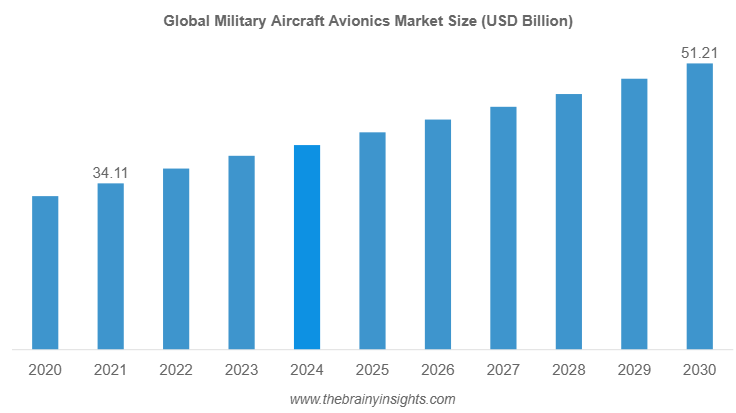
Military Aircraft Avionics Market Overview:
The Military Aircraft Avionics market refers to the systems and electronic components used in military aircraft to ensure proper operation, communication, navigation, targeting, and defense. These avionics systems play a crucial role in enhancing the performance and efficiency of military aircraft, providing situational awareness, and improving safety and mission success. With technological advancements, the market is expanding, as defense sectors demand increasingly sophisticated systems for combat and surveillance operations.
The global military aircraft avionics market is projected to grow to USD 51.21 billion by 2030, with a compound annual growth rate (CAGR) of 4.62% from 2022 to 2030.
Market Dynamics:
- Drivers:
- Technological Advancements: Rapid developments in avionics technologies, such as radar, navigation systems, and communication equipment, are driving growth in this sector.
- Modernization Programs: Many military forces are investing in the modernization of older aircraft with new avionics systems, which boosts market demand.
- Increasing Defense Budgets: Countries globally are increasing their defense spending, which directly affects the procurement of advanced military aircraft and associated avionics systems.
- Restraints:
- High Cost of Technology: Advanced avionics systems are often expensive, which can limit their widespread adoption, especially in developing countries.
- Complexity of Integration: Integrating avionics systems into existing aircraft, particularly older models, can be technically challenging and costly.
- Opportunities:
- Emerging Markets: Countries in the Middle East, Asia-Pacific, and Africa are increasing their defense budgets, providing significant opportunities for growth in avionics sales.
- Advanced Communication Systems: The need for more secure and effective communication systems in military operations offers opportunities for innovation in avionics technologies.
Regional Analysis:
- North America: The U.S. is a significant player in the military aircraft avionics market, owing to its high defense budget and the presence of major manufacturers such as Lockheed Martin, Northrop Grumman, and Raytheon Technologies. The demand for modern, high-tech avionics in fighter jets, bombers, and surveillance aircraft is particularly strong.
- Europe: European countries like the UK, France, and Germany also contribute significantly to the market. NATO countries are investing in aircraft upgrades and new procurement programs that require advanced avionics systems.
- Asia-Pacific: Countries like China, India, and Japan are modernizing their military fleets, and the region is expected to witness rapid growth in the military aircraft avionics market. China, in particular, is investing heavily in its defense sector, including next-generation avionics systems.
- Middle East & Africa: Nations in this region, particularly in the Gulf Cooperation Council (GCC), are modernizing their air forces and investing in cutting-edge avionics systems for their fighter jets and surveillance aircraft.
Segmental Analysis:
- By Platform:
- Fighter Aircraft
- Helicopters
- Bombers
- Transport Aircraft
- Unmanned Aerial Vehicles (UAVs)
- By Avionics System:
- Communication and Navigation Systems
- Radar Systems
- Flight Control Systems
- Weapon Control Systems
- Surveillance and Targeting Systems
- By End-User:
- Defense Ministries
- Military Contractors
- Aerospace and Defense Manufacturers
List of Key Players:
- Lockheed Martin
- Raytheon Technologies
- Northrop Grumman
- Thales Group
- Honeywell International
- Saab AB
- BAE Systems
- L3Harris Technologies
- Rockwell Collins
- General Electric
Key Trends:
- Increase in Digital Avionics Systems: Digital avionics systems are increasingly being integrated into military aircraft due to their superior capabilities, which include better performance, higher reliability, and easier maintenance.
- Miniaturization of Components: There is a growing trend toward miniaturizing avionics components to reduce weight and enhance fuel efficiency while maintaining or improving performance.
- Integration of Artificial Intelligence (AI): AI is being incorporated into avionics for enhanced mission planning, real-time decision-making, and autonomous flight systems.
- Advanced Communication Networks: Secure communication channels and advanced data-sharing technologies are crucial for modern military operations, pushing demand for sophisticated avionics communication systems.
Request PDF Brochure: https://www.thebrainyinsights.com/enquiry/sample-request/12810
Conclusion:
The military aircraft avionics market is poised for growth, driven by technological advancements, modernization efforts, and increasing defense spending globally. The development of cutting-edge systems such as AI-powered avionics, advanced radar, and communication technologies will continue to transform the defense sector. With significant investments from emerging markets and major defense contractors, the future of the market looks promising.
